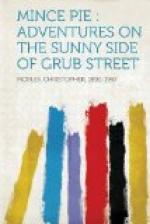As I left the ferry at Market Street I saw that the Norwegian steamer Taunton was unloading bananas at the Ericsson pier. Less than a month ago she picked up the survivors of the schooner Madrugada, torpedoed by a U-boat off Winter Bottom Shoal. On the Madrugada was a young friend of mine, a Dutch sailor, who told me of the disaster after he was landed in New York. To come unexpectedly on the ship that had rescued him seemed a great adventure. What a poem Walt Whitman could have made of it!
II
It is a weakness of mine—not a sinful one, I hope—that whenever I see any one reading a book in public I am agog to find out what it is. Crossing over to Camden this morning a young woman on the ferry was absorbed in a volume, and I couldn’t resist peeping over her shoulder. It was “Hans Brinker.” On the same boat were several schoolboys carrying copies of Myers’ “History of Greece.” Quaint, isn’t it, how our schools keep up the same old bunk! What earthly use will a smattering of Greek history be to those boys? Surely to our citizens of the coming generation the battles of the Marne will be more important than the scuffle at Salamis.
My errand in Camden was to visit the house on Mickle Street where Walt Whitman lived his last years. It is now occupied by Mrs. Thomas Skymer, a friendly Italian woman, and her family. Mrs. Skymer graciously allowed me to go through the downstairs rooms.
I don’t suppose any literary shrine on earth is of more humble and disregarded aspect than Mickle Street. It is a little cobbled byway, grimed with drifting smoke from the railway yards, littered with wind-blown papers and lined with small wooden and brick houses sooted almost to blackness. It is curious to think, as one walks along that bumpy brick pavement, that many pilgrims from afar have looked forward to visiting Mickle Street as one of the world’s most significant altars. As Chesterton wrote once, “We have not yet begun to get to the beginning of Whitman.” But the wayfarer of to-day will find Mickle Street far from impressive.
The little house, a two-story frame cottage, painted dark brown, is numbered 330. (In Whitman’s day it was 328.) On the pavement in front stands a white marble stepping-block with the carved initials W.W.—given to the poet, I dare say, by the same friends who bought him a horse and carriage. A small sign, in English and Italian, says: Thomas A. Skymer, Automobiles to Hire on Occasions. It was with something of a thrill that I entered the little front parlor where Walt used to sit, surrounded by his litter of papers and holding forth to faithful listeners. One may safely say that his was a happy old age, for there were those who never jibbed at protracted audience.
A description of that room as it was in the last days of Whitman’s life may not be uninteresting. I quote from the article published by the Philadelphia Press of March 27, 1892, the day after the poet’s death:




